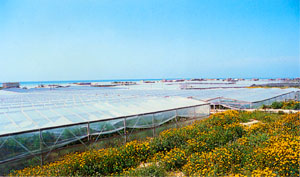
CLINTON, TENN. (April 19, 2019) –– Fogging in greenhouse films is a problem. Conventional antifogging (AF) films simply are not very effective. Fogging can reduce light transmission, lower crop yields by slowing plant growth, and even lead to plant damage from burning due to the “lens effect” of water droplets.
How exactly do antifog additives work anyway? AF additives migrate to the polyethylene film’s surface, increasing the surface tension of the polymer. Their affinity to water droplets also tends to lower the surface tension of the water. The resulting lower surface energy creates a hydrophilic effect, with a smaller contact angle for water droplets to form on the film. This results in better transparency and visibility through the clear film, with little or no fog formation.
By contrast, effective antifogging films can enhance light transmission, improve crop ripening rates, and reduce crop damage (by limiting mold growth and “lens effect” burning damage), thereby boosting a grower’s overall productivity.
As a materials design company that thrives on challenges, Techmer PM was motivated to help find a more effective antifogging solution for this problem plaguing greenhouse growers. This required an indepth understanding of molecular structure, polymer chemistry, and additive technology. The result is a Techmer hybrid polymer called Multi-Season Antifog, which can be custom tailored as needed.
“Our approach was to functionalize the backbone of the polymer,” according to Abe Mor, chief technology officer. “Doing so increased the molar volume of the AF additive, allowing for controlled or elimination of diffusion of the additive, which extends AF’s effective lifespan.”
Various factors impact the mobility of the additives in a polymer, such as molecular weight and structure of the additive, its compatibility with the host polymer, and the processing temperature. High solubility
in water and high diffusion rates can cause a premature loss of AF additives from the polymer, making it vital to control the diffusivity of the additive to lengthen the effectiveness of the antifog properties.
To prove the efficacy of its new antifog technology, Techmer PM developed an in-house test method to accelerate and scale performance results, which were later validated through full-scale field testing. Prior to field testing, instrumentation analysis via Fourier Transform Infrared Spectroscopy
(FTIR) analysis revealed that conventional AF suffered a 15.2 percent loss after accelerated AF testing, meaning it would lose 41 percent of its functional antifog group by volume after oven aging at 70°C and four weeks of heat exposure. The same analysis of Techmer’s Multi-Season AF revealed it had suffered only a 1 percent loss after accelerated AF testing.
A traditional greenhouse film typically loses its antifogging performance after six months in the field. Under harsher and warmer climates, the loss of performance would be even greater.
“Based on Techmer’s rigorous testing, we estimate the performance of our Multi-Season Antifog to last up to four times longer than traditional antifogging technologies. This breakthrough technology should be a huge advantage for the agriculture market,” says Steve Loney, Techmer PM’s director of market
development.
Techmer PM’s highly engineered, long-lasting Multi-Season Antifog with a hybrid polymeric structure results in no restriction on light transmission and photosynthesis active radiation (PAR). There is no interference with infrared-ray properties and thermicity of the film.
The resulting film is durable, offers extended antifog life, increases overall greenhouse production yield, and saves on labor cost for installing new antifog films so frequently.
Greenhouse growers worldwide can be grateful that Techmer PM has once again demonstrated innovation through material design and boosted their crop yields in the process.
For more information on Multi-Season Antifog or to discuss other challenges needing the expertise of Techmer PM’s talented chemists, designers, and material engineers, please contact us.